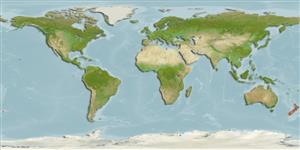>
Gobiesociformes (Clingfishes) >
Gobiesocidae (Clingfishes and singleslits) > Trachelochisminae
Etymology: Trachelochismus: Greek, trachelos = neck + Greek, schismos, -ou = cut (Ref. 45335).
More on author: Forster.
Environment: milieu / climate zone / depth range / distribution range
Ökologie
seewasser demersal; tiefenbereich 0 - 70 m (Ref. 116173). Temperate
Southwest Pacific: endemic to New Zealand.
Size / Gewicht / Alter
Maturity: Lm ? range ? - ? cm
Max length : 10.0 cm TL Männchen/unbestimmt; (Ref. 9003)
Kurzbeschreibung
Morphologie | Morphometrie
Rückenflossenstacheln (insgesamt): 0; Rückenflossenweichstrahlen (insgesamt): 7-9; Afterflossenstacheln 0; Afterflossenweichstrahlen: 5 - 7. Pink to red or green dorsally, possibly with longitudinal bands of brown, or spotted brown and yellow. Occasionally with patches of pink over the dorsal surface. Pale creamy white ventrally. Distinguished from other clingfishes by the broad, bluntly pointed head, a thick, fleshy upper lip and a longitudinal groove below the eye lined with fleshy lobes. The sucking disc lacks flattened papillae across the anterior margin.
Common in rock pools at mid to low tide and in subtidal areas. Usually found clinging under rocks of exposed areas. Feeds on small mollusks, polychaete worms, amphipods, and other crustaceans.
Life cycle and mating behavior
Geschlechtsreife | Fortpflanzung | Ablaichen | Eier | Fecundity | Larven
Paulin, C. and C. Roberts, 1992. The rockpool fishes of New Zealand (Te ika aaria o Aotearoa). Museum of New Zealand (Te Papa Tongarewa). 177 p. (Ref. 9003)
IUCN Rote Liste Status (Ref. 130435)
Bedrohung für Menschen
Harmless
Nutzung durch Menschen
Mehr Information
NamenSynonymeMetabolismusRäuberÖkotoxikologieFortpflanzungGeschlechtsreifeAblaichenSpawning aggregationFecundityEierEientwicklung
Alter/GrößeWachstumLänge-GewichtLänge-LängeLängenhäufigkeitenMorphometrieMorphologieLarvenLarven Pop.Dyn.RekrutierungDichteBRUVS
ReferenzenAquakulturAquakultur ProfilZuchtlinienGenetikElectrophoresesVererbbarkeitKrankheitenVerarbeitungNutrientsMass conversion
PartnerBilderStamps, Coins Misc.LauteCiguateraGeschwindigkeitSchwimmstilKiemenoberflächeOtolithsGehirngrößeSehfähigkeit
Tools
Zusatzinformationen
Download XML
Internet Quellen
Estimates based on models
Preferred temperature (Ref.
123201): 13.8 - 19.4, mean 16.5 °C (based on 106 cells).
Phylogenetic diversity index (Ref.
82804): PD
50 = 0.7500 [Uniqueness, from 0.5 = low to 2.0 = high].
Bayesian length-weight: a=0.00468 (0.00180 - 0.01212), b=3.12 (2.89 - 3.35), in cm total length, based on LWR estimates for this (Sub)family-body shape (Ref.
93245).
Trophic level (Ref.
69278): 3.4 ±0.46 se; based on food items.
Widerstandsfähigkeit (Ref.
120179): mittel, Verdopplung der Population dauert 1,4 - 4,4 Jahre. (Preliminary K or Fecundity.).
Fishing Vulnerability (Ref.
59153): Low vulnerability (10 of 100).
